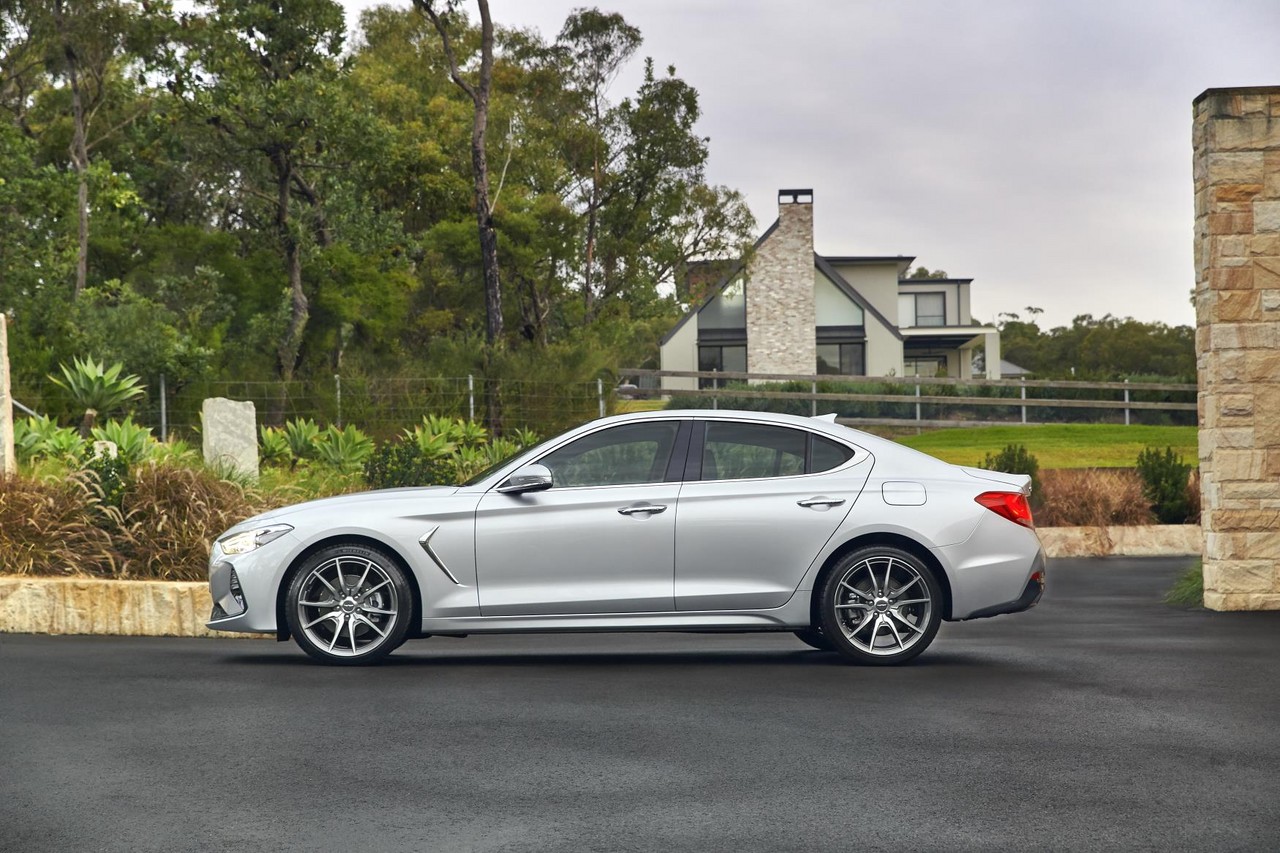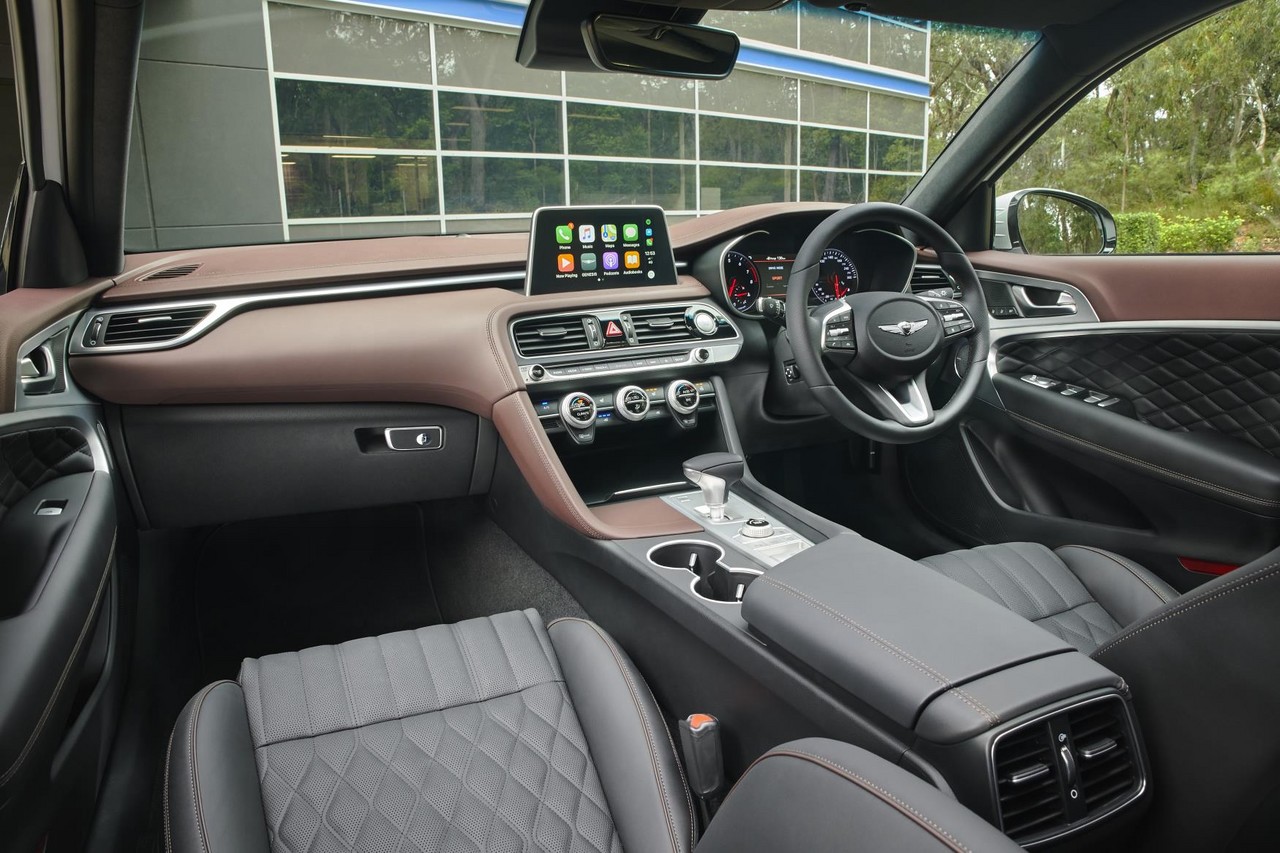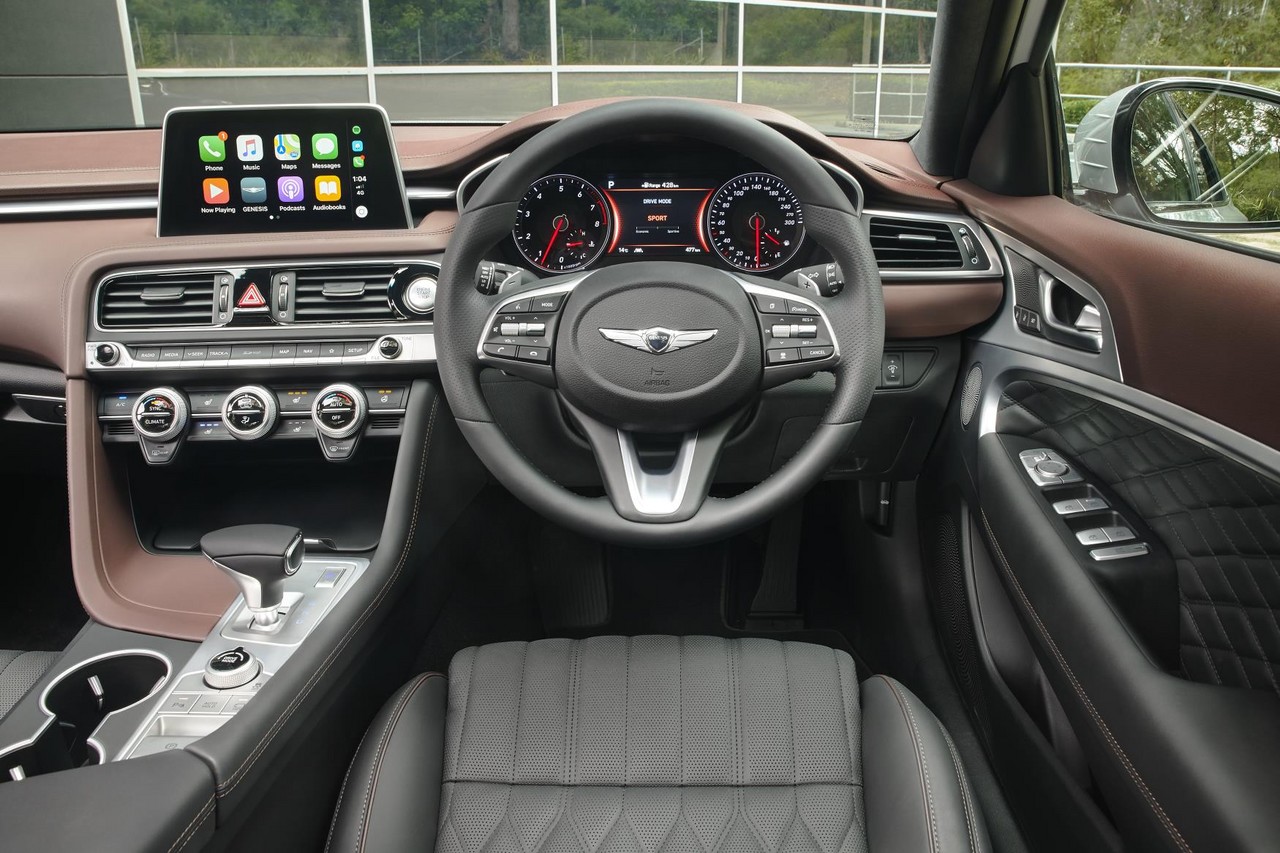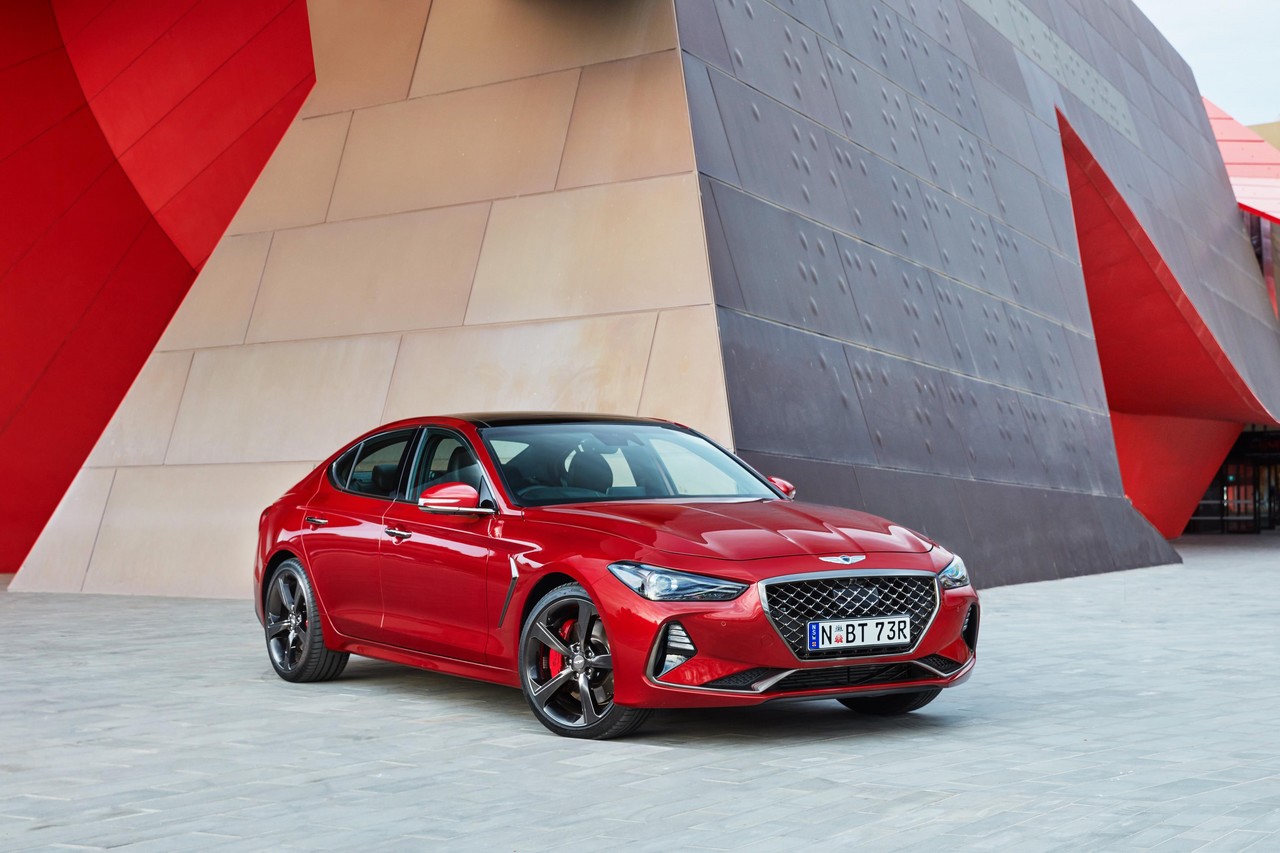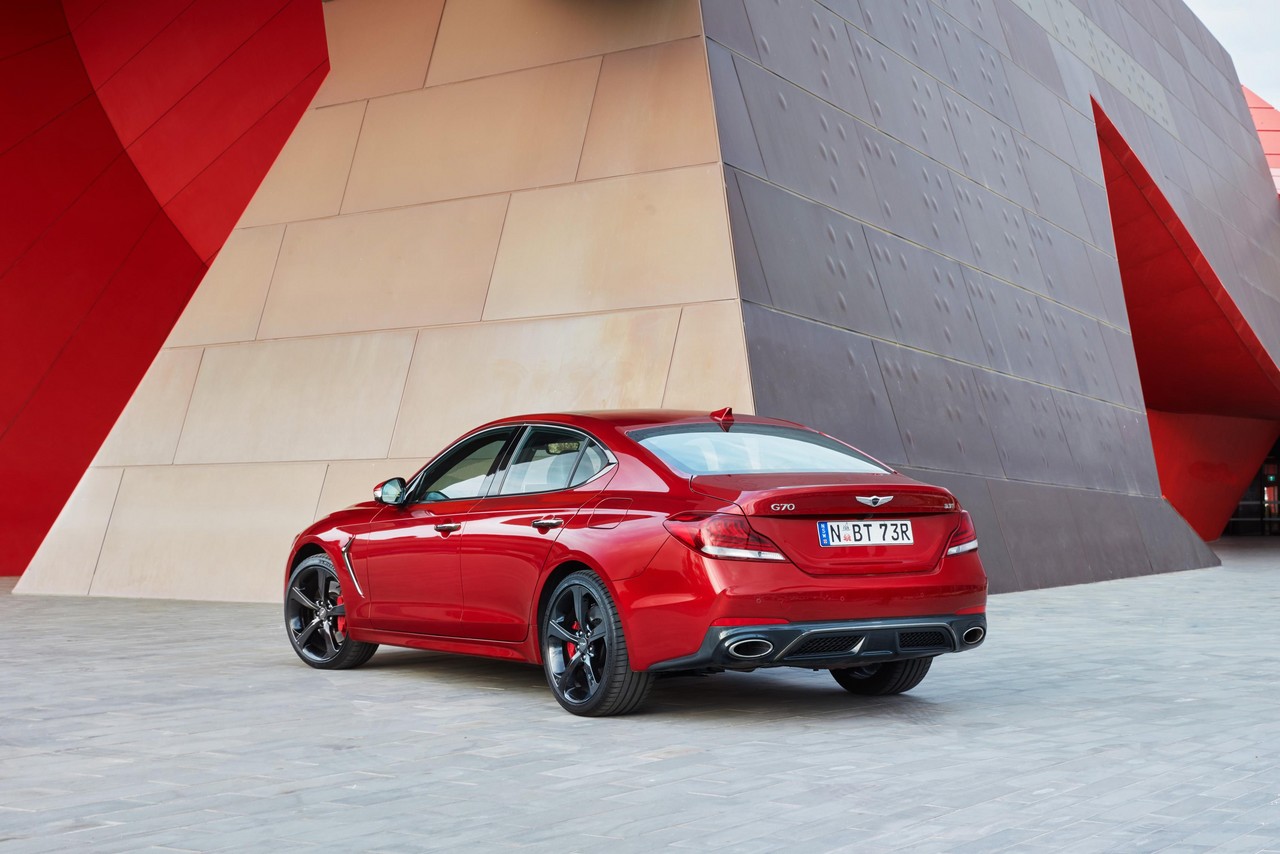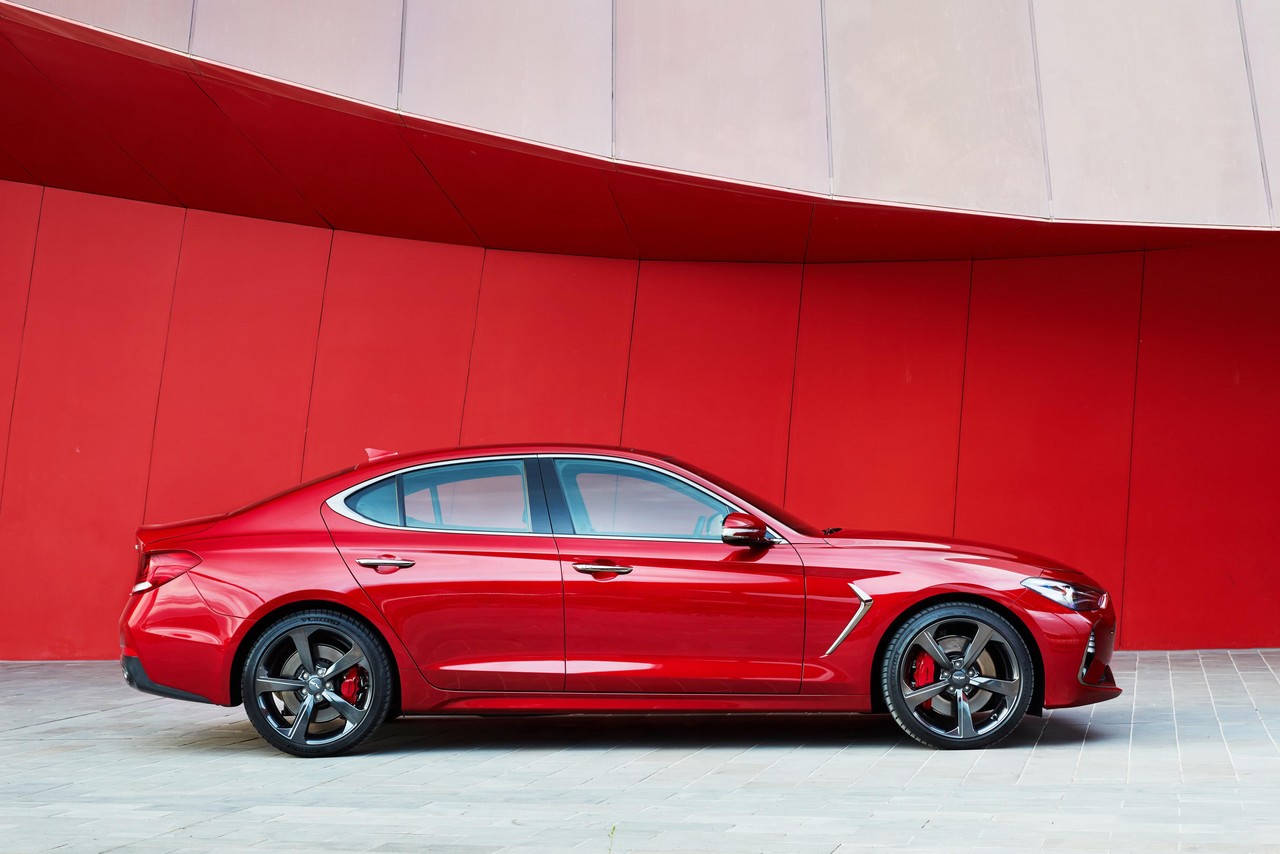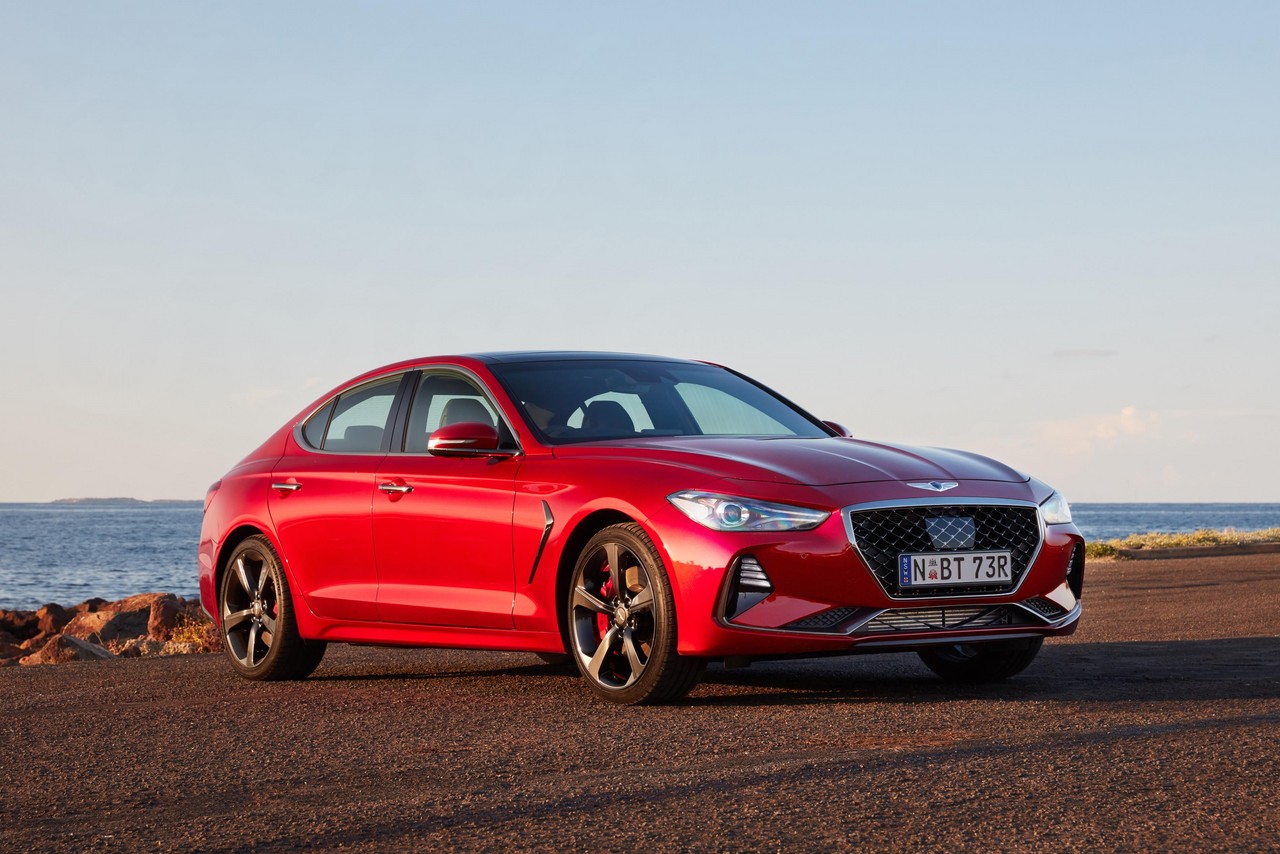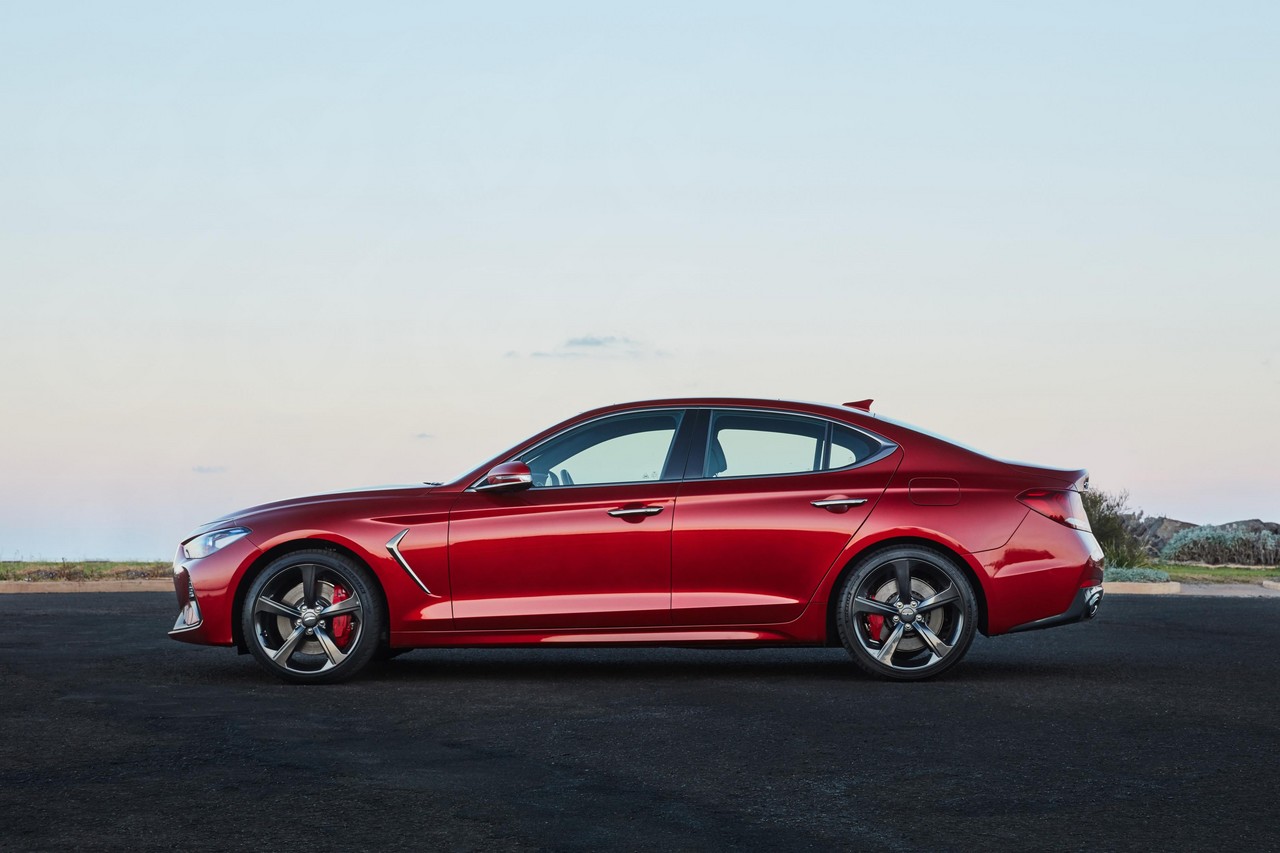
- Powerful 3.3-litre biturbo V6 engine
- Accomplished ride/handling balance
- More expensive than the larger and related Kia CK Stinger
- Active safety technologies as standard and five star ANCAP safety rating
- Five year warranty and complimentary servicing
- Genesis brand lacks recognition and its future is uncertain
- Long bonnet reduces interior space
- Small boot
- Interior switchgear lacks tactility of rivals
- Eight-speed automatic transmission not as intuitive as rivals
- Noise from Michelin Pilot Sport 4 tyres on coarse-chip roads
- 300 km/h speedometer for ‘sports instrumentation’ is a pointless gimmick
- Engines require 95 RON unleaded petrol
Overview
Released in Australia in June 2019, the Genesis IK G70 was a compact executive sedan. Manufactured in Ulsan, South Korea, the rear-wheel drive Genesis G70 was available with 2.0-litre turbo four-cylinder and 3.3-litre biturbo V6 petrol engines, both of which were mated to eight-speed automatic transmissions. The Genesis G70 was sold with a five-year, unlimited kilometre warranty which included complimentary servicing.
Shared with the Kia CK Stinger , both the 2.0-litre G4KL ‘Theta II’ and 3.3-litre G6DP ‘Lambda II’ engines had aluminium alloy blocks and cylinder heads, double overhead camshafts, four valves per cylinder and compression ratios of 10.0:1. However, the G4KL engine had a single twin-scroll turbocharger whereas the G6DP engine had twin single-scroll turbochargers.
To reduce fuel consumption, the G6DP engine for the Genesis G70 3.3T had an ‘Eco Coasting’ function. Operating at speeds between 55 km/h and 160 km/h, Eco Coasting would engage neutral when coasting to reduce mechanical resistance.
| Engine | Trans. | Peak power | Peak torque | |
|---|---|---|---|---|
| 2.0T, 2.0T Sport, 2.0T Ultimate |
1998 cc ‘Theta II’ G4KL turbo petrol I4 | 8sp auto | 179 kW at 6200 rpm | 353 Nm at 1400-4000 rpm |
| 3.3T Sport, 3.3T Ultimate, 3.3T Ultimate Sport |
3342 cc ‘Lambda II’ G6DP biturbo petrol V6 | 8sp auto | 272 kW at 6000 rpm | 520 Nm at 1300-4500 rpm |
Body and dimensions
The Genesis IK G70 was underpinned by Hyundai’s rear-wheel drive platform which was shared with the Kia CK Stinger . Compared to the Kia Stinger, however, the Genesis IK G70 was 146 mm shorter (at 4685 mm), 19 mm narrower (1850 mm), the same height (1400 mm) and had a 71 mm shorter wheelbase (2835 mm). Furthermore, the Genesis G70 had a drag co-efficient of 0.28 Cd, while boot capacity was 330 litres (VDA method).
Unladen masses for the Genesis IK G70 ranged from 1646 kg (2.0 T-GDI) to 1725 kg (3.3 T-GDI). To reduce mass, the Genesis G70 used aluminium for suspension components, its bonnet, front bumper beam, rear parcel tray, differential housing and steering components. Genesis claimed that the use of aluminium reduced mass by 30 kg.
Suspension and steering
The Genesis IK G70 had MacPherson strut front suspension and multi-link rear suspension. Furthermore, Australian-delivered Genesis G70 vehicles had locally-tuned suspension that was developed by Hyundai Australia’s engineering team.
The Genesis G70 3.3T had Genesis Adaptive Control Suspension (GACS) which consisted of Electronic Control Suspension (ECS) and Dynamic Stability Damping Control (DSDC). The Electronic Control Suspension used electronically controlled dampers that could adjust compression and rebound forces up to 100 times per second.
The Genesis G70 had rack-and-pinion steering with a rack-mounted electric motor for power assistance. Furthermore, the Genesis G70 3.3T variants had variable gear ratio (VGR) steering which reduced the steering ratio in proportion to vehicle speed for easy manoeuvring.
The Genesis G70 2.0T Sport and all 3.3T variants were fitted with a mechanical multi-plate clutch-type limited slip differential at the rear axle to improve torque distribution between the rear wheels.
Safety equipment
Standard safety equipment for the Genesis G70 included dual front airbags, a driver’s knee airbag, front seat-mounted side airbags, full-length curtain airbags (i.e. for front and rear occupants), ABS, electronic brake force distribution, brake assist, electronic stability control, traction control and front seatbelts with pre-tensioners and load limiters.
For Australian deliveries, the Genesis G70 was equipped with the following ‘Genesis Active Safety Control’ technologies:
- Forward Collision-Avoidance Assist – Car, Pedestrian, Lane-Change Oncoming (FCA – Car/Ped/LO): active at speeds between 10 km/h and 180 km/h, this system used a camera mounted on the windscreen and a radar sensor in the front grille to scan the road ahead. If sensors detected that the Genesis G70 was rapidly approaching a vehicle, the driver would receive visual and audible alerts. If the driver failed to respond, emergency braking would be initiated autonomously to reduce vehicle speed. The Lane-Change Oncoming (LO) function was active at speed above 60 km/h and could detect an oncoming vehicle when the Genesis G70 was driven over the centre line. In such situations, steering torque would return the Genesis G70 back to its lane;
- Smart Cruise Control with stop & go (SCC with S&G): operating at speeds between 30 km/h and 200 km/h, SCC used a sensor in the front grille to detect traffic and would provide autonomous braking and acceleration to maintain a safe distance from the vehicle ahead. The stop & go function enabled the Genesis G80 to be brought to rest and the vehicle would automatically accelerate if the road ahead cleared and it had been stationary for less than three seconds;
- Lane Keeping Assist – Line/Road-Edge (LKA-L/R): operating at speeds above 60 km/h, LKAS monitored the vehicle’s position within its lane. While the Lane Departure Warning (LDW) would sound an alarm and provide steering wheel vibrations if the Genesis G70 crossed lane markings, LKAS would use corrective steering to guide the vehicle back to a safe position within its lane. Both LDW and LKA were momentarily deactivated when the turn indicators were active;
- Blind-spot Collision Warning (BCW): operating at speeds above 30 km/h, BSW used the windscreen-mounted camera to monitor the Genesis G70’s position in its lane and rear radar sensors to detect vehicles that were adjacent to and in the driver’s blind spot. If detected, BCW would display an alert in the door mirrors and the Head-Up Display (HUD). If the driver activated the indicators, a flashing warning and an alert would be issued;
- Rear Cross-Traffic Collision Warning (RCCW): when reversing out of perpendicular parks at speeds under 10 km/h, RCCW scanned areas on each side of the vehicle and would warn of approaching traffic that could intersect the G70’s path provided it was travelling at speeds between 4 km/h and 36 km/h;
- High Beam Assist (HBA): active at speeds above 45 km/h, HBA could detect the headlights or tail-lights of traffic at night and automatically dip the high beam headlights to reduce glare. When no vehicles were detected, the system would revert to the high beam headlights; and,
- Driver Attention Warning (DAW): operating at speeds between 60 km/h and 200 km/h, DAW monitored lane position, steering inputs and driving time. If careless driving was detected, the five-stage ‘Attention Level’ display in the instrument cluster would be progressively engaged.
The Genesis G70 also had an ‘Active Bonnet Lift System’. In the event of a pedestrian collision at speeds between 25 km/h and 50 km/h, actuators would raise the bonnet to increase the distance between it and hard points in the engine bay to reduce the severity of a pedestrian’s impact.
ANCAP testing
In ANCAP testing , the Genesis G70 received a five star safety rating which included an 81 per cent adult occupant protection rating and an 86 per cent child occupant protection rating. In the frontal offset test, protection of the driver’s head, thighs, lower right leg and feet were rated as good, though protection of the chest and lower left leg were rated as adequate (i.e. a slight risk of serious injury). Maximum points were awarded in the side impact test; in the more severe pole test, however, chest protection was rated as marginal (i.e. moderate risk of serious injury).
Wheels, tyres and brakes
The Genesis G70 2.0T had 8.0J x 18-inch wheels with 225/45 R18 Continental ContiSportContact5 tyres. Beyond this, the Genesis G70 2.0T had 320 mm by 28 mm ventilated front brake discs and 314 mm by 13 mm solid rear discs. The Genesis G70 2.0T Sport, 2.0T Ultimate and G70 3.3T variants, however, had 8.0J x 19-inch front wheels with 225/40 ZR19 Michelin Pilot Sport 4 tyres and 8.5J x 19-inch rear wheels with 255/35 ZR19 tyres.
The Genesis G70 2.0T Sport, 3.3T Ultimate and 3.3T Ultimate Sport had a Brembo braking package which consisted of 350 mm by 30 mm ventilated front brake discs with four-piston monobloc callipers and 340 mm by 22 mm ventilated rear discs with two-pison monobloc callipers.
Features: Genesis G70 2.0T
The standard infotainment system for the Genesis G70 consisted of an 8.0-inch multimedia display, satellite navigation with SUNA live traffic updates, a nine speaker audio system with digital amplifier, digital radio tuner (DAB+), Apple CarPlay and Android Auto smartphone integration, and wireless mobile phone charging (Qi standard). The Genesis G70 also had a 7.0-inch TFT-LCD within its instrument cluster.
Beyond this, standard features for the Genesis G70 2.0T included a twelve-way power adjustable and heated front seats, leather upholstery, dual-zone climate control air conditioning, bi-LED headlights, dusk-sensing headlights, rain-sensing wipers, LED daytime running lights, a rear view monitor (RVM) with parking guidelines, steering wheel gearshift paddles, remote central locking with proximity key, power adjustable and heated door mirrors with folding function, power windows, tilt and telescopic steering wheel adjustment, an electrochromic mirror, an electronic parking brake, a 12 volt power outlet, two USB power outlets, push-button start, tyre pressure monitoring, floor mats, an alarm and immobiliser.
The Genesis G70 2.0T also had ‘Parking Distance Warning-Forward/Reverse’ (PDW-F/R). Operating at speeds below 10 km/h, PDW-F/R used eight surround sensors (four front and four rear) to alert the driver to surrounding objects, while the area behind the vehicle was displayed on the central display.
Features: Genesis G70 2.0T Sport and 3.3T Sport
Compared to the Genesis G70 2.0T, the G70 2.0T Sport and 3.3T Sport had black headlining, stainless steel pedals and ‘sports instrumentation’ (i.e. a 300 km/h speedometer, digital oil temperature gauge, digital torque gauge, digital boost pressure gauge, digital lap timer and digital g-force meter).
Visually, the G70 2.0T Sport and 3.3T Sport could be identified by their ‘sport dark chrome’ exterior packages which included a Genesis ‘Crest’ grille, front bumper lower garnish, window frame and beltline moulding, front guard vent garnish, black bezels and copper highlights for the headlights, and darkened tail-light lenses.
Features: Genesis G70 2.0T Ultimate and 3.3T Ultimate
Relative to the G70 2.0T, the Genesis G70 2.0T Ultimate and 3.3T Ultimate were equipped with a ‘Lexicon’ by Harman audio system which had fifteen speakers, a 660 watt digital amplifier, eleven channel ‘QuantumLogic’ surround sound and Clari-Fi music restoration technology.
Beyond this, the G70 2.0T Ultimate and 3.3T Ultimate featured a sixteen-way power adjustable driver’s seat, ventilated front seats, heated outboard rear seats, Nappa leather upholstery, head-up display, a heated steering wheel, power adjustable steering column, suede headlining, ‘Easy Access’ function for the driver’s seat and steering wheel, electrochromic door mirrors, kerbside view for the door mirrors when reversing, driver memory settings (for the driver’s seat, door mirrors, instrument panel and head-up display), a panoramic glass sunroof and an ‘acoustic’ laminated windscreen.
The Genesis G70 Ultimate variants were also equipped with:
- Surround View Monitor: could display a virtual bird’s eye view of the Genesis G70 and surrounding objects on the 8.0-inch HD central display; and,
- Adaptive Front-Lighting System (AFS): turned the headlight beams in the same direction as the steering wheel and provided automatic height levelling.
Furthermore, the Genesis G70 3.3T Ultimate had sports instrumentation.
Features: Genesis G70 3.3T Ultimate Sport
Compared to the G70 3.3T Ultimate, the Genesis G70 3.3T Ultimate Sport was distinguished by its black headlining, stainless steel pedals and ‘sport dark chrome’ exterior package as per the G70 2.0T Sport and 3.3T Sport variants.

